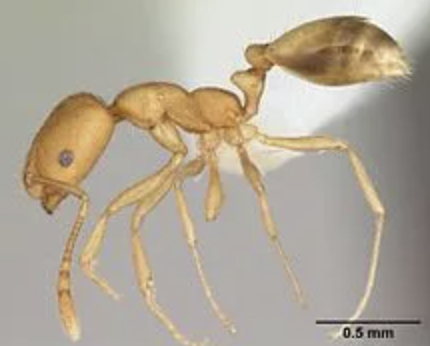Vancouver Ant Control
Call NowVancouver Ant Removal
Ants produce some of the most potent antibiotics and antimicrobial organisms known to man. Current research is going on isolating and reproducing them. The bodies of most ants are virtually germ free. They have impeccable grooming habits, and take great pride in keeping themselves clean! Their saliva has antibacterial properties This allows them to live in highly concentrated colonies without spreading disease to each other. With over 14,000 formal scientific names given to ants, there are still many more to be documented. New species, especially in tropical rain forests around the world, are discovered every year.
Contact Us
We will look over every inch of your commercial or industrial premises with care and vigilance. Let us help you become pest free now!
Get in Touch
Carpenter Ants
Carpenter ants get their name because they build their nests in wood. This pest can cause significant damage to your house. The most common carpenter ants in BC are:
Modoc: all black. Legs may have a rusty red colour. One queen in parent nest.
Vicinus: black head, rusty red thorax and black abdomen tail section. Multiple queens in parent nest.
Each colony is established by a single, fertilized queen. She starts her nest in a cavity in wood, where she raises her first brood of workers. She feeds them saliva and does not leave the nest or feed herself during this time. When they are ready, those workers then get the job of gathering food to feed the next generation. Once mature, this first generation of worker ants work to increase the food supply for the colony. The colony population grows very rapidly. A colony
can eventually produce 2,000 or more workers.
Size: 5/8″
Colour: Range in colour from red to black
Wings: Varies
Diet: Carpenter ants do not eat the wood they remove during their nest-building activities, but deposit it outside entrances to the colony in small piles. This material resembles sawdust and is called frass. The diet of carpenter ants includes living and dead insects, meat, fats and sugary foods of all kinds, including honeydew and nectar from plants.
Habitat: Carpenter ants build nests anywhere they can find water and mouldy or damp wood, such as tree stumps, firewood or in the plants around your house. Carpenter ants also build nests inside, usually entering buildings through wet, damaged wood, although it isn’t uncommon for them to adapt to drier environments.
Impact: Carpenter ants don’t carry disease, but when building a nest inside a home, Carpenter ants dig smooth tunnels inside the wood. These tunnels weaken the wood and potentially damage the wood that keeps the house standing. This kind of damage can be very expensive to fix.
Prevention: Eliminate and correct any moisture issues within your structure. Keep tree branches and other plants cut back from the house. Make sure that firewood and building materials are not stored next to your home.
Pharaoh Ants

Size: 1.5 to 2 millimeters
Color: Yellow to light brown in color, darker abdomen, appears translucent
Wings: Varies
Diet: The workers will at first show a strong preference for a particular food type. However, if this food is offered alone, with no other options, for several weeks, workers will afterward show a distinct preference for a different type of food. In this way, the ants become satiated on a certain food group and will change their decision. The second behavior is called alternation. If given the continuous choice between food groups, Pharaoh ants will tend to alternate between carbohydrate-rich foods and protein-rich foods.
Habitat: Tropical Climates
Impact: Can transmit over a dozen pathogens such as Salmonella, Staphylococcus, and Streptococcus to humans.
Prevention: Pharaoh ants are a tropical species and no not live outside in our climate. These are usually introduced into a building; A potted plant may harbour ants within the soil.
Odorous Ants

Size: 1/16″ to 1/8″
Shape: Segmented, oval
Color: Brown or black
Wings: Varies
Diet: Odorous house ants like to eat dead insects and sugary sweets, especially melon.
Habitat: Typically living for several years, these ants commonly make their homes in exposed soil, under stones, logs, mulch, debris and other items. They will also nest in wall and floor cracks.
Impact: Odorous house ants do not pose a health threat, but they can contaminate food by leaving waste behind.
Prevention: Maintain good sanitation practices.
Pavement Ants

Size: 1/8″
Color: Dark brown to black
Wings: Varies
Diet: These ants will eat almost anything, including insects, grease, seeds, honeydew, honey, bread, meats, nuts and cheese.
Habitat: This ant gets its name because it most commonly nests in soil next to and beneath slabs, sidewalks, patios, and driveways. Indoors, pavement ants nest under a building’s foundation and within hollow foundation walls.
Prevention: Maintain good sanitation practices.
Fire Ants

Size: 4-5 mm
Color: reddish-brown
Shape: 2 nodes, rearward-pointing spines
Wings: Varies
Diet: European fire ants are omnivorous and eat both plant and decaying animal matter.
Habitat: Fire ants like moist environments and often establish nests inside decaying logs, in soil, under rocks or debris, and even in potted plants. They don’t nest in obvious large mounds. European fire ants establish their nests in the root zone of vegetation.
Impact: The European fire ant is an aggressive, swarming ant that can deliver a painful sting when disturbed. In uncommon cases this has led to allergic reactions that have required medical treatment.











